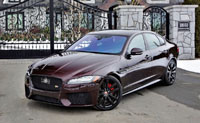
Let me guess, that even if you live in one of Canada’s more established neighbourhoods you don’t often lay eyes on a Jaguar XF, let alone a lot of XE or XJ sedans. While once prolific in luxury crowds, four-door cars from Coventry are becoming rare sightings indeed.
Thanks to the stunningly beautiful Mk II and extremely elegant XJ Series I, II and III that followed, not to mention the B-Type, C-Type and E-Type sports cars that were inspirational for today’s sensational F-Type, the Jaguar brand grew legendary, but this day and age it seems that luring luxury customers into anything lower to the ground than a crossover SUV is becoming much more difficult, and it’s not for a lack of styling.
When the current XJ was completely reimagined for 2009, its wholly original, beautifully proportioned design set the stage for an entirely new lineup of Jaguar sedans and crossovers, but other than the latter lineup of SUVs, which are selling fairly well, it hasn’t exactly followed that bases-loaded homerun with an encore hit.
The second-generation mid-size E-segment XF being reviewed here arrived in 2015 as a 2016 model, and is beautifully sculpted too. Like the XJ and almost every Jaguar vehicle it’s formed from aluminum panels and composites, but only the XF can claim the brand’s best-ever drag coefficient of 0.26.

So it’s beautiful, lightweight and hails from an iconic brand, but that still doesn’t make it popular. It almost seems as if you need to be a curator of curious collectibles before stepping up and taking ownership of a car like the XF, but then again exclusivity has its privileges. It’s not like you’ll see one driving down the neighbourhood lane every day, or every other week for that matter. Crowd pleasers won’t like this one whit, but those who choose to be unique in order to stand out from that crowd will find the XF’s rarity a bonus. After all, while the XF is scarce, it’s hardly unusual in the way it goes about pleasing driver and occupants, combining a high level of old school charm with strong performance and plenty of highly advanced tech gear.
Jaguar actually improved the XF’s technology for this 2019 model, so that all XF trims now incorporate the brand’s updated 10.0-inch InControl Touch Pro infotainment touchscreen, which provides a larger display area to appreciate its completely new and wholly simpler graphics package (the classic red British telephone box ahead of a pastoral background and other scenes are now gone), easier visibility of the rearview camera, greater detail of the navigation mapping, plus plenty of other enhancements. If the more minimalist, arguably more sophisticated digital interface is not up to your standards, Apple CarPlay and Android Auto smartphone integration provide a new look when attached to your device, plus add proprietary features. Being that I’ve been an Android convert for the past few years (after getting fed up with lame iPhone batteries) I chose to use Jaguar’s stock system that’s much more appealing to look at. Incidentally, features like navigation and voice recognition are available in the XF’s second-rung Prestige trim and above.

Moving from tech to luxury, Jaguar’s super-soft Suedecloth is now standard on all XF roof pillars and headliners, as are aluminum treadplates with illuminated Jaguar branding, plus premium carpeted floor mats, metal foot pedals, chromed power seat switchgear, and a classy looking frameless auto-dimming rearview mirror.
Speaking of standard, the base 2019 XF is the $59,100 Premium, while other trims include the $64,500 Prestige, and $67,800 R-Sport when opting for the 247 horsepower 2.0-litre direct-injection turbo four-cylinder; the $67,000 Prestige, $70,300 R-Sport, $72,300 300 SPORT and $79,100 Portfolio when choosing the 296 horsepower version of the same gasoline-powered mill; the $66,500 Prestige and $69,800 R-Sport when hooked up to the 180 horsepower 2.0-litre four-cylinder diesel; and finally $75,300 for my tester’s 380 horsepower 3.5-litre supercharged V6-powered model’s sole S trim. These prices and trims, incidentally, plus packages and standalone options can be found right here at CarCostCanada, where you can also choose to save thousands by learning about available rebates and otherwise difficult to access dealer invoice pricing.
The diversity of available XF engines is actually quite amazing and rare, but all of these engines focus their energies on one tried and tested eight-speed automatic gearbox, no matter the trim. The quick yet smooth transmission boasts an innovative rotating gear selector that automatically powers upwards after startup from an otherwise flush placement on the lower console between the front seats, this system requiring standard paddle shifters for utilizing the Jaguar Sequential Shift manual mode, while all-wheel drive is also standard.
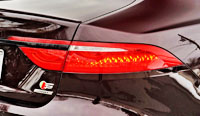
Further improving control no matter the driving situation, all XF trims come fitted with Jaguar Drive Control featuring Standard, Eco, Dynamic (sport), and Rain/Ice/Snow driving modes, each making a considerable difference to comfort, performance and all of the above, while Torque Vectoring by Braking (TVBB), and hill launch assist further aid drivers in mastering most road conditions.
Specific to my XF S tester, Adaptive Surface Response (AdSR) plus Configurable Dynamics and Adaptive Dynamics allow the choice of personal engine, suspension, steering, and transmission settings. All made a big difference to how this Jaguar responded to inputs, from being a comfortable, relaxed luxury car one moment, to a seriously responsive sports sedan the next.
Together with all items already noted, the top-tier XF S shown on this page receives beefier 350-mm front brake rotors and red calipers all around, as well as 20-inch alloy wheels, the latter upgrade improving performance and styling measurably.
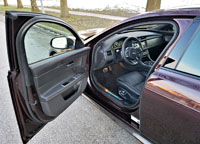
Staying on the styling theme, the XF S also receives a unique “S” body kit that dresses up the car with a sportier front bumper, glossy black side sills and a gloss-black rear valance, plus a subtle rear deck spoiler. When stepping inside you’ll bypass special metal treadplates finished with unique “S” branding, while great looking Dark Hex aluminum inlays improve the instrument panel, rich Luxtec leatherette covers the dash top, and superbly comfortable, ultra-supportive “S” embossed 18-way powered sports seats ensconce driver and front passenger.
On top of everything already mentioned, the XF S also includes proximity keyless entry, pushbutton start/stop, an acoustic layer windshield, auto on/off headlamps, rain-sensing wipers, an electronic parking brake, a powered tilt and telescopic steering wheel, auto-dimming, power-folding, heated side mirrors with approach lamps and puddle lights, memory for those mirrors as well as the front seats, front seat warmers, mood lighting, a universal garage door opener, a backup camera, navigation, InControl Apps, Pro Services, Bluetooth phone and audio streaming, a USB port, two-zone auto HVAC, front and rear parking sonar, and more.
Additionally, along with the segment’s usual active and passive safety systems, the XF S arrives standard with autonomous emergency braking, lane keeping assist, blindspot monitoring, closing vehicle sensing, reverse traffic monitoring, driver condition monitoring, etcetera.
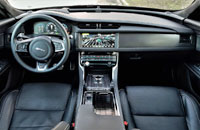
Over and above the standard XF S items already listed, my test car was upgraded to include a stunning Rossello Red paint job for $670; beautiful glossy black twinned five-spoke alloy wheels for $770; a special Black package featuring a glossy black mesh grille insert and surround, glossy black side vents, and the same inky treatment for the trunk garnish for $460; a Comfort and Convenience package for $2,200 that adds a overly excitable gesture-control system for the trunk’s powered lid (I’ll explain this in a moment); plus soft closing doors, three-way active cooled/ventilated front seats, and heated rear seats; a Technology package for $1,030 featuring a 12.3-inch digital gauge cluster, Pro Services, and a CD/DVD changer; a Driver Assistance package for $3,680 incorporating an overhead surround camera system, a forward-facing camera, 360-degree Park Distance Control, Park Assist semi-autonomous self-parking, dynamic cruise control with Queue Assist, blindspot assist, and traffic sign recognition with an intelligent speed limiter; a $1,330 head-up display system; a $410 heated windshield and heated washer jets package; plus $210 satellite and HD radio.
Only the $2,230 Premium Interior Upgrade package was missing or my XF S would be deemed fully loaded, the improvement otherwise adding four-zone auto HVAC with an air quality sensor and auto air re-circulation, plus a cooled glove box, side window sunshades, a powered rear sunshade, and configurable mood lighting; plus I might have enjoyed one of the optional interior décor trims more too, particularly the carbon fibre; yet even the way Jaguar provided it, the XF S was sensational and its asking price of $85,850 quite reasonable, this $10,550 more than the base XF S.

All of the features just noted are fastened to a lightweight and extremely rigid bonded and riveted aluminum body shell that I happen find extremely attractive, while the interior is very well made from some of the industry’s nicest leathers, woods and metals. My test car featured an Ebony (aka black) leather and Light Oyster (grey) contrast-stitched cabin that also boasted gorgeous Grey Figured Ebony veneers throughout. While impressive, especially when compared to Jaguar’s smaller XE sedan, I won’t go so far as to claim that the XF leads its class when it comes to fit, finish, materials quality, digital interface supremacy, feature superiority, ultimate roominess, or any other superlative. Still, it gets a good grade for all noted categories, while its completely unique look, feel, and overall impressive performance warrants your undivided attention.
Just like the more compact XE and full-size XJ, the XF actually drives like a smaller, lighter and more engaging car than its long, mid-size dimensions suggest, and most competitors can offer. Its previously noted 380 horsepower V6 responds with immediate energy that’s easily attributed to its sizeable displacement and aforementioned supercharger, which helps all 332 lb-ft of torque hit the ground running from launch, while its standard all-wheel drive makes wheel spin yesterday’s news in snow, rain or dry conditions, and the aforementioned ZF eight-speed clicks through its cogs with speed and precision.
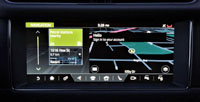
The XF’s performance is its key calling card, from its steady, formidable (albeit exhaust-muted) 5.3-second zero-to-100km/h straight-line acceleration, to its sublime handling and excellent ride that’s brought about by a lightweight double-wishbone front suspension and integral link rear setup, the combination perfect for pushing the envelope through hard-pressed switchbacks at unmentionable speeds, or alternatively hauling down the highway or taxiing through town at more relaxed paces. The XF S is a sport-luxury sedan that can do it all.
This said I had a few issues with my test car, particularly the fact that my top-tier model didn’t even include remote engine start on the otherwise fancy key fob. It’s available as part of the InControl Remote App you can download onto your smartphone, but there were plenty of disgruntled iTunes and Play Store owners who said it only worked 25-30 percent of the time, and being that I only tested it for a week and was never even informed of the app prior to the test so I could download it, wasn’t able to pre-warm the interior in winter (or hypothetically pre-chill the cabin in summer).
Temperature settings in mind, I didn’t appreciate not having an auto mode for the heatable seats and steering wheel. Each needed to be switched on upon startup, and Jaguar only includes one ultra-hot setting for the steering wheel rim, forcing me to turn it on and off throughout my drive.
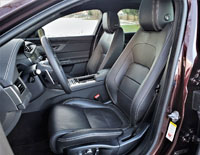
Another quibble focuses on the overhead sunglasses holder that doesn’t even properly fit smallish wire rim glasses like my Ray-Ban aviators. I had to turn them upside down in order to stuff them inside and shut it closed, which meant their lenses were left rubbing against the harder side of the lid.
On a more positive note, the dash corner vents whisk open in wonderful silence, which is equally cool to how the gear selector rises into place, but all the hard plastic found on the glove box lid, lower dash surfacing, console, and lower door panels didn’t impress anywhere near as well.
Finally I get to that trunk lid I mentioned earlier in the review. Hyperactive might be a better term than overly excitable, but either way it was a convenience feature gone wrong. Let me explain: Basically it opens up whenever anyone with the key fob in purse or pocket walks past. Other carmakers that use this type of hands-free trunk opener, such as Hyundai and its Genesis luxury division, cause you to stand next to the back bumper for at least three seconds before it activates the automatic trunk lid, but my XF tester’s trunk kept popping open immediately upon sensing the key fob. Once, after pulling up at a shopping centre, the trunk sprang open as I walked past on my way toward the mall. Unfortunately this gave a nice preview of my valuables to any miscreant eyes nearby, which is certainly a security risk. Another time I kept the engine running (for less than a minute) while delivering something to an office I have regular business with (don’t worry, their parking lot/entrance is totally private), and voila, while walking past the XF’s backside the trunk lid popped open once again. It performed the annoying ritual while pumping gas too, and on other occasions.
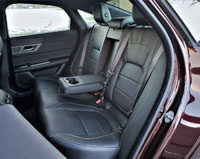
Fuel in mind, the XF achieves a Transport Canada rating of 12.0 L/100km city, 8.4 highway and 10.4 combined, which is actually pretty decent for such an enthusiastic drivetrain strapped to such as generously proportioned luxury sedan, although I must point out that buyers willing to forgo some accelerative force for thriftier economy can choose the aforementioned turbo-diesel that gets a superb 7.8 city, 5.8 highway and 6.9 combined rating. Diesel is often significantly cheaper than gasoline too, and allows you to drive greater distances per tankful.
While that trunk kept popping open I was continually reminded just how large it is. It measures a generous 541 litres (19.1 cubic feet), and better yet provides ultra-convenient 40/20/40 split-folding rear seats that let you lay longer items like skis down the middle while outboard rear passengers enjoy the more comfortable, warmer window seats.
The XF is spacious for front and rear occupants as well, this due to a wheelbase that was lengthened considerably when the second-gen car arrived. By the numbers you’ll have 1,055 mm of legroom in front while your rear passengers will benefit from 957 mm, so you shouldn’t hear complaints from tagalongs when it comes to roominess.
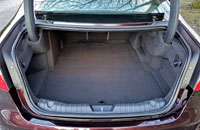
At the end of my weeklong test I wouldn’t say I was in love with the 2019 XF S, but certainly grew to appreciate its many qualities despite its few quirks. Yes, it’s nowhere near perfect, but its larger touchscreen and other improvements make it better than ever, while its performance was excellent for all but those (like me) that have experienced this car with a supercharged V8. That in mind, I’d consider the XF even more seriously with one of its four-cylinder alternatives, for its economical and environmental benefits. Either way, Jaguar has most bases covered with the XF, making it a credible choice in this highly competitive mid-size luxury category.
Story credit: Trevor Hofmann
Photo credit: Karen Tuggay
